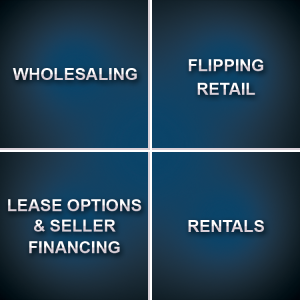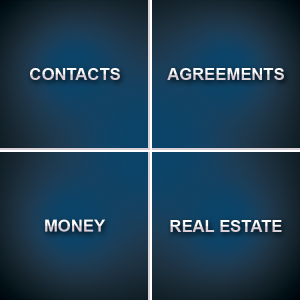Real Estate Investing Roadmap


Join RealEstateInvesting.com
Have an account? Sign In
By joining you agree to the Terms of Use and Privacy Policy
 Log In
Log In

© 1997-2024 · RealEstateInvesting.com
Real Estate Investing Roadmap
Beginning real estate investors are often confused one where to start or what areas to focus on when getting started. Even some more experienced investors seek a broader understanding of how to focus on the foundation for doing more deals. To assist, this website is laid out with a navigation structure meant to allow newer investors to understand the components of real estate investing & have a better mental picture for where and how to take action.

Breaking Things Down Into Quadrants
Several New York Times bestselling books have used a quadrant system to break ideas down into more understandable & manageable components for easier learning & management. “The 7 Habits Of Highly Successful People” (1989) by Steven R. Covey uses quadrants to break down & organize time management. “Rich Dad Poor Dad” (1997) by Robert Kiyosaki uses the Cashflow Quadrant to break down the different types of income derived from being self-employed, an investor, business owner or employee.
Real Estate Investing can also be broken down into quadrants for easier understanding & for taking action. First, the types of investment deals or strategies you can do when dealing with residential properties can be broken down into four main quadrants or categories. Second, each of those types of deals can further be broken down into their four main components which make up a real estate investing deal. For newer investors, it is key to understand the four main types of deals you can do and then understand the four main components which make up a real estate investment.

DEAL QUADRANTS
The majority of residential real estate investing deal types fall into one of four categories or quadrants. Here are some basic overviews:
WHOLESALING is where you get a property under contract to purchase which gives you & equitable interest in the property. You can then sell or assign your contract & equitable interest for a fee without needing to have a real estate license.
FLIPPING RETAIL is buying a property which needs work, fixing it up & then selling the property to a home buyer or long term investor. (A cross strategy between “Wholesaling” & “Flipping Retail” is a strategy called “Wholetailing” which involves putting a property under contract which needs little to no work, then making very minor cosmetic improvements & then relisting & selling the property at a higher price.)
LEASE OPTIONS & SELLER FINANCING are a way of creating a deal based mainly on the terms. This is where you sometimes hear you can make money on properties which are 100% financed & have no equity. By structuring highly favorable “terms”, you create value in a deal & can profit in multiple ways.
RENTALS is of course buying a property & then renting it out to a tenant, but in today's market there are a lot of unique opportunities to buy turnkey rentals which are already rehabbed & rental out with professional management in place. You also have opportunities to invest in large investments deals by participating in “real estate crowd funding”.

ACTION QUADRANTS
Every real estate investing deal can be broken down into for main components you must take action to assemble when doing a deal:
CONTACTS are all the people you deal with when doing a real estate deal. This includes such contacts as other investors & wholesalers, sellers, buyers, real estate agents, contractors, appraisers, & closing agents just to name a few. Building & constantly expanding your team of contacts is an essential first step to real estate investing
AGREEMENTS are the contracts and paperwork which put a deal in writing along with other agreements such as those with contractors & your closing documents just to name a couple. Knowing & understanding the various agreements used in real estate investing is another key requirement to being a successful investor.
MONEY covers the funding of a real estate deal whether it be seller financing, hard money, a private loan, a conventional loan or even cash. Understanding the money side of real estate investing is key to even doing deals with no money down.
REAL ESTATE Of course, every real estate deal wouldn't be complete without the actual real estate property itself; however, this is the last quadrant/component for a reason. Many beginning investors seek the real estate component first without having a foundation of contacts, an understanding of the agreements or an understanding of structuring the money side to an investment. Understanding & having the first three components in-line ahead of time will help give you the confidence & knowledge to execute a real estate deal.
WEBSITE NAVIGATION
This website has the navigation setup with the breakdown just covered making it easier for you to access the investment strategies as well as the individual components of a real estate investment deal. In the menus you will find a section title “I Need Help With…” which outlines the two sets of quadrants/categories. Further, we have added a section for “Getting Started” as well as a section for “Passive Investing” which goes more in-depth into buying & owning passive rental properties as well as real estate crowd funding.


Have an account? Sign In
By joining you agree to the Terms of Use and Privacy Policy
 Log In
Log In

© 1997-2024 · RealEstateInvesting.com